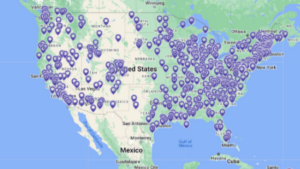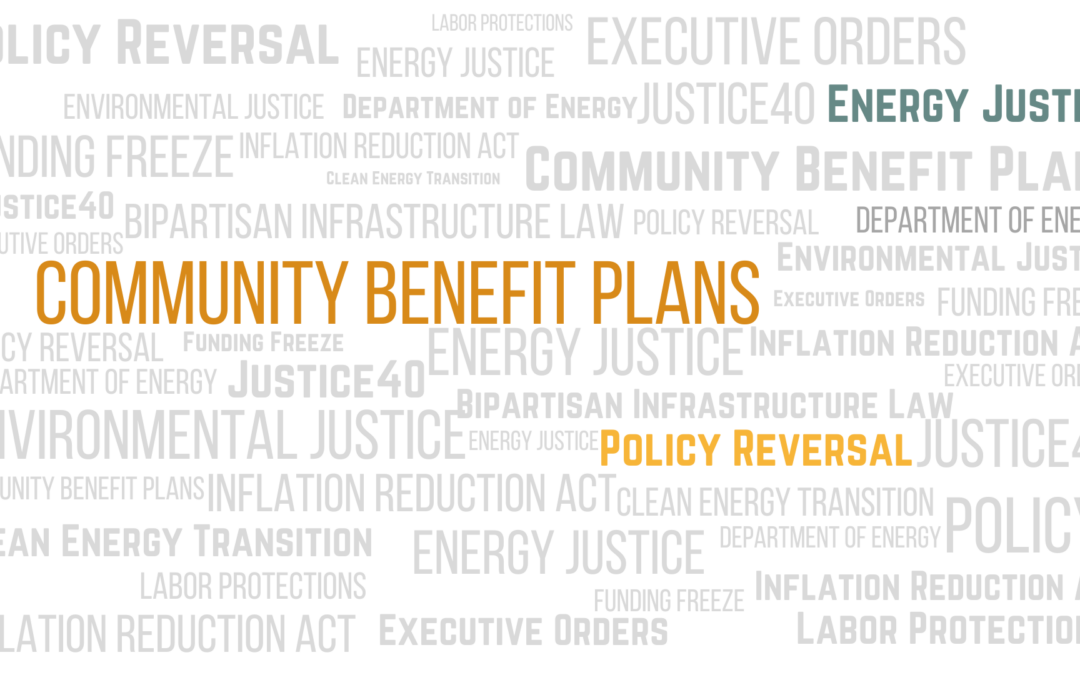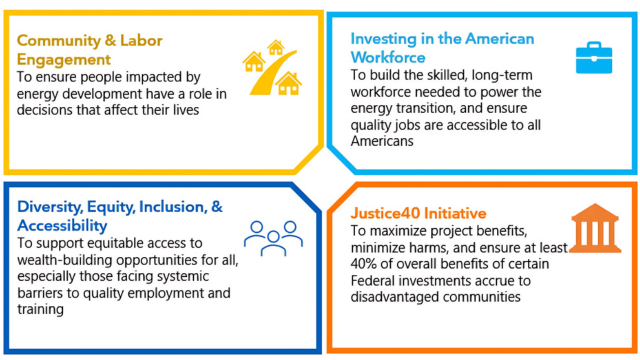Feb 19, 2025
Evelyn Mayo
One of the first actions taken by the Trump Administration on January 20, 2025, was rescinding Executive Orders and releasing new ones, many of which may have ramifications for energy justice gains made during the Biden Administration.1 The rapid and high volume of executive orders, the lack of clarity around the legality of some elements, and the lack of specificity in programs impacted have led to significant confusion in and outside the Federal Government. This analysis examines the potential implication for the $97 billion in investments made through the Department of Energy (“DOE”) from the Bipartisan Infrastructure Law (“BIL”) and Inflation Reduction Act (“IRA”) pertaining to labor and community benefits.
Background on Community Benefits Plans
A major component of the IRA and BIL DOE grant process was the creation of “Community Benefit Plans” or “CBPs”.2 The inclusion of CBPs in DOE programming was in alignment with the Biden-Harris Administration’s Investing in America agenda, to ensure projects receiving funding from the DOE had transparent and comprehensive community engagement processes, delivering tangible benefits to both workers and communities.3 The DOE provided specific guidance on the types of activities that aligned with their four priorities for CBPs. including Community and Labor Engagement, Job Quality and Workforce Continuity, Diversity, Equity, Inclusion and Accessibility, and Justice40.4
Applicants had to demonstrate in their proposal how they met the various criteria included in the DOE CBP template, with the CBP equating up to 20% of the technical merit points for project proposals.5 This means to score high in that category, those criteria had to be demonstrated. The Trump administration has removed mos t CBP-related information previously hosted on the DOE website, however, this map of grantees is still a live link (for now), demonstrating grantee geographic and bipartisan scope.6
t CBP-related information previously hosted on the DOE website, however, this map of grantees is still a live link (for now), demonstrating grantee geographic and bipartisan scope.6
CBP Implementation Framework
The CBP template created by the DOE provided significant guidance for the criteria considered in a successful CBP, including specific labor mechanisms to align with the stated workforce development and labor goals. Some specific commitments the DOE outlined that applicants could make included: “commitment to negotiate Collective Bargaining Agreements, Community Benefits Agreements, Community Workforce Agreements, and/or Good Neighbor Agreements”.7
Additional DOE educational materials detailed in the construction phase of projects for applicants to consider including “commitments to negotiate Project Labor Agreements for large construction activity associated with the project.”8 Project Labor Agreements (“PLAs”) are “intended to provide a legally binding and enforceable contract related to labor conditions and labor-management relations” and noted that “negotiations for PLAs typically occur between one or more labor unions and the project owner or manager”.9 As part of the DEIA component of the CBP metric, applicants were encouraged to identify Minority, Women and Diverse Business Enterprise firms and Minority Serving Institutions as partners to contract with. A key element of energy justice is ensuring that marginalized communities experience material benefits from the energy system and that strong labor protections and practices are embedded in the clean energy transition. CBPs and PLAs specifically are potential tools for both those ends.
Recent Executive Orders and Their Impact
However, President Trump’s Executive Order entitled “Ending Racial and Wasteful Government DEI Programs and Preferencing” and “Unleashing American Energy” released in January 2025, include language targeting programs with CBPs, Diversity Equity and Inclusion, and Justice40 elements.10
The DOE has responded with several key administrative actions:
- Immediate suspension of CBP requirements
A memo published by the DOE Office of Science on January 28, 2025, states that they are “moving aggressively to implement” the executive orders by suspending “requiring, using or enforcing Community Benefits Plans (CBPs); and requiring, using or enforcing Justice40 requirements”.11 - Modification of existing grant agreements
A memo published the day before by the DOE advises that “recipients who have DEI and CBP activities in their awards will be contacted by their Grants Officer to initiate award modifications consistent with this Order”.12 - Revision of proposal requirements
The “Unleashing American Energy” Order related to the freezing of fund disbursements through the IRA and BIL doesn’t explicitly call out CBPs, but as part of the memo from the OMB released shortly after to clarify how to implement this Order, it stated that all Federal Agencies must submit a checklist to determine the applicability of the EO to specific programs.13 The form must be completed and returned to the Office of Management and Budget by February 7, 2025, includes questions about whether funding includes “illegal DEI” mandates or “environmental justice” programs.14
Current Status: Legal Challenges and Grantee Response
Grant recipients range from grassroots organizations to various state agencies, spurring advocacy by all parties, including their representatives in the Senate and Congress, to determine the legality of the freeze and requests to renegotiate contracts that include CBPs. A coalition of nonprofits and 22 states (and D.C.) sued the Trump administration for the funding freeze, which is blocking the order for now.15 The memo published by the DOE on January 27 indicated that awards would be modified and that “costs incurred after the date of this letter will not be reimbursed” as they pertain to CBP activities. The January 28 memo from the DOE Office of Science stated that for “proposals that have already been submitted to the Office of Science, no action on the part of the applicant is required, but applicants will have the option to resubmit a new application with the removal of the PIER [Promoting Inclusive and Equitable Research] plan”.16
DOE grant recipients may be uniquely positioned at this time. They are being asked to change their activities outlined in their contracts to remove CBPs and Justice40 elements and, depending on their specific grant, they may be included within the broader funding freeze if their grant is focused on environmental justice or equity. This makes understanding the implications for DOE grant recipients even more challenging.
Options for Grantees
Guidance from various private law firms for grantees on how to respond to these Orders has been released including monitoring the news, internally auditing their programs that could be impacted, seeking legal counsel, and recording costs incurred related to the changes or pause.17 According to Holland & Knight “historically, a contractor could recover breach of contract damages, which include anticipatory (lost) profits, as a result of a termination based on inherent authority. United States v. Speed, 75 U.S. 77 (1868).” However, “convenience termination clauses preclude the contractor from recovering “anticipatory profits or consequential damages” (or lost profits) when the government, in good faith, terminates the contract for its convenience.”18 This article outlines some key questions regarding the powers of the Executive Branch in changing or rescinding funding for federal grants and agreements.19
Looking Forward: Energy Justice in an Era of Federal Policy Uncertainty
Amending federal contracts to remove CBPs has the potential to harm the positive steps the DOE has taken to embed labor protections through PLAs, and other community benefits in alignment with Justice40 goals. While the legality of the funding freeze plays out in court and grantees attempt to navigate contract compliance, we will continue to track the implications of these Executive Orders on furthering energy justice through community and worker benefits and see how grantees respond.
There is tremendous momentum around the transition to clean energy across the country that integrates local workforce development, building wealth and opportunity for marginalized communities. The steps taken by the Trump administration are far-reaching, but in spite of these actions, the clean energy transition, and energy justice movement won’t be stopped.
About Community Benefits & Governance
The transition to a more equitable energy system requires reimagining how communities interact with and benefit from energy infrastructure. To advance policy that centers on energy justice, communities must experience material benefits from the energy system and have decision-making authority over energy infrastructure. Benefits can include monetary payments, pollution remediation, infrastructure investment, jobs programs, and health improvements. Policy interventions that account for, track, and allocate meaningful community benefits are key to policy change.
Our community benefits research aims to provide partners with practical tools and knowledge, summarizing lessons learned from diverse community benefit approaches to inform more just and responsive energy policies.
Endnotes
1. Exec. Order No. 14148 Fed. Reg. 8237 available at https://www.whitehouse.gov/presidential-actions/2025/01/initial-rescissions-of-harmful-executive-orders-and-actions/
2. Community Benefits Plans Overview, The Office of Clean Energy Demonstrations, https://www.energy.gov/sites/default/files/2023-09/OCED%20CBP%20101%20Factsheet.pdf (last visited Feb. 19, 2025)
3. DOE Loan Programs Office Publishes Community Benefits Plans for Energy Projects, Power, https://www.powermag.com/doe-loan-programs-office-publishes-community-benefits-plans-for-energy-projects/ (last visited Feb. 19, 2025)
4. Community Benefits Plans Overview, The Office of Clean Energy Demonstrations, https://www.energy.gov/sites/default/files/2023-09/OCED%20CBP%20101%20Factsheet.pdf (last visited Feb. 19, 2025)
5. Community Benefits Plan Template https://view.officeapps.live.com/op/view.aspx?src=https%3A%2F%2Fwww.energy.gov%2Fsites%2Fdefault%2Ffiles%2F2023-05%2FCommunityBenefitsPlanTemplate.docx&wdOrigin=BROWSELINK (last visited Feb. 19, 2025)
6. DOE Launches Map Highlighting Benefits to Communities Selected for Biden-Harris Clean Energy Projects, https://www.energy.gov/infrastructure/articles/doe-launches-map-highlighting-benefits-communities-selected-biden-harris (last visited Feb. 19, 2025)
7. Community Benefits Plans Overview, The Office of Clean Energy Demonstrations, https://www.energy.gov/sites/default/files/2023-09/OCED%20CBP%20101%20Factsheet.pdf (last visited Feb. 19, 2025)
8. Community Benefits Plans Overview, The Office of Clean Energy Demonstrations, https://www.energy.gov/sites/default/files/2023-09/OCED%20CBP%20101%20Factsheet.pdf (last visited Feb. 19, 2025)
9. Community Benefits Plans Overview, The Office of Clean Energy Demonstrations, https://www.energy.gov/sites/default/files/2023-09/OCED%20CBP%20101%20Factsheet.pdf (last visited Feb. 19, 2025)
10. Exec. Order No. 14151 Fed. Reg. 8339 available at https://www.whitehouse.gov/presidential-actions/2025/01/ending-radical-and-wasteful-government-dei-programs-and-preferencing/
11.Executive Order Update to PIER Plan Requirement, https://www.energy.gov/science/articles/executive-order-update-pier-plan-requirement (last visited Feb. 19, 2025)
12.Memorandum for All DOE Funding Agreements or Awards, https://perma.cc/7TU9-GMA3 (last visited Feb. 19, 2025)
13. Exec. Order No. 14154 Fed. Reg. 8353 available at) https://www.whitehouse.gov/presidential-actions/2025/01/unleashing-american-energy/ (last visited Feb. 19, 2025)
14.Instructions for Federal Financial Assistance Program Analysis in Support of M-25-13, https://mcusercontent.com/0554cc7ed0bda904329a48c93/files/27f51312-5aa4-beed-0213-5eddf027b320/2025_01_28_OMB_M_25_13_Instructions.pdf (last visited Feb. 19, 2025)
15. Nonprofit’s lawsuit over the federal funding freeze is part of an ‘avalanche’ of litigation, Associated Press, https://apnews.com/article/nonprofit-lawsuit-executive-order-federal-funding-grants-b61b41392b10c95ce35da511ead92124 (last visited Feb. 19, 2025)
16. Executive Order Update to PIER Plan Requirement, https://www.energy.gov/science/articles/executive-order-update-pier-plan-requirement (last visited Feb. 19, 2025)
17. Stop Work Orders Under the Trump Administration’s New Executive Orders and “Pause” of Federal Grants, Arnold & Porter, https://www.arnoldporter.com/en/perspectives/advisories/2025/01/stop-work-orders-and-pause-of-federal-grants-eo (last visited Feb. 19, 2025)
18.What to Do in the Event of Federal Procurement Disruptions, Holland & Knight, https://www.hklaw.com/en/insights/publications/2025/02/what-to-do-in-the-event-of-federal-procurement-disruptions (last visited Feb. 19, 2025)
19. Federal Grants Impacted by Executive Orders of the New Administration, Feldesman, https://www.feldesman.com/client-advisory-federal-grants-impacted-by-executive-orders-of-the-new-administration/ (last visited Feb. 19, 2025)


